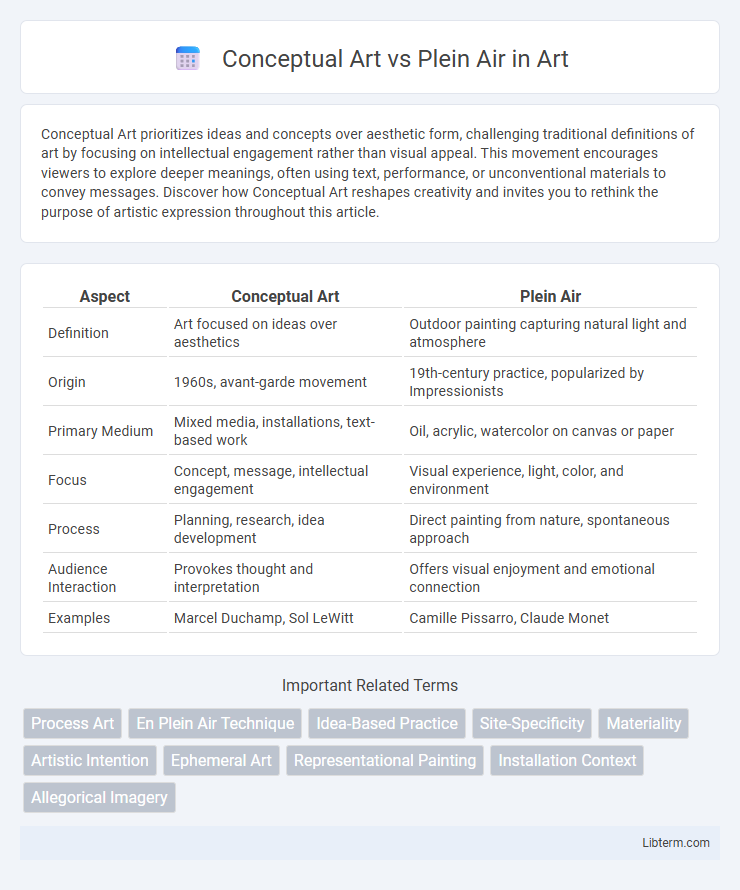Conceptual Art prioritizes ideas and concepts over aesthetic form, challenging traditional definitions of art by focusing on intellectual engagement rather than visual appeal. This movement encourages viewers to explore deeper meanings, often using text, performance, or unconventional materials to convey messages. Discover how Conceptual Art reshapes creativity and invites you to rethink the purpose of artistic expression throughout this article.
Table of Comparison
| Aspect | Conceptual Art | Plein Air |
|---|---|---|
| Definition | Art focused on ideas over aesthetics | Outdoor painting capturing natural light and atmosphere |
| Origin | 1960s, avant-garde movement | 19th-century practice, popularized by Impressionists |
| Primary Medium | Mixed media, installations, text-based work | Oil, acrylic, watercolor on canvas or paper |
| Focus | Concept, message, intellectual engagement | Visual experience, light, color, and environment |
| Process | Planning, research, idea development | Direct painting from nature, spontaneous approach |
| Audience Interaction | Provokes thought and interpretation | Offers visual enjoyment and emotional connection |
| Examples | Marcel Duchamp, Sol LeWitt | Camille Pissarro, Claude Monet |
Defining Conceptual Art
Conceptual Art prioritizes ideas and concepts over traditional aesthetic and material concerns, emphasizing intellectual engagement rather than visual representation. It often utilizes text, documentation, and performance to communicate artistic intentions, challenging conventional definitions of art objects. In contrast, Plein Air painting focuses on capturing direct impressions of natural light and atmosphere by painting outdoors, emphasizing sensory experience and visual accuracy.
Understanding Plein Air Painting
Plein air painting emphasizes capturing natural light and atmosphere by working outdoors, directly observing the scene to convey authentic color and mood. This approach contrasts with conceptual art, which prioritizes ideas and symbolic meaning over direct representation. Understanding plein air painting involves recognizing its commitment to spontaneity and sensory experience in natural environments.
Historical Origins and Influences
Conceptual Art emerged in the 1960s as a movement prioritizing ideas over visual forms, heavily influenced by earlier avant-garde practices such as Dada and Fluxus, challenging traditional notions of art's materiality. Plein Air painting traces its roots to the 19th century, particularly associated with the French Impressionists like Claude Monet, who emphasized capturing natural light and atmosphere by working outdoors. These distinct historical origins reflect Conceptual Art's intellectual rebellion against conventional aesthetics and Plein Air's dedication to direct observation and naturalistic representation.
Key Philosophies Behind Each Style
Conceptual Art prioritizes the idea or concept over the physical artwork, emphasizing intellectual engagement and challenging traditional aesthetics. Plein air painting centers on capturing natural light and atmosphere through direct observation, reflecting immediacy and sensory experience in natural settings. The key philosophical divide lies in Conceptual Art valuing meaning and thought, while Plein Air prioritizes sensory perception and real-time interaction with the environment.
Techniques and Artistic Processes
Conceptual Art emphasizes ideas and meanings over traditional aesthetic techniques, employing methods like text, installation, and performance to challenge conventional representations. Plein Air painting relies on direct observation of natural environments, using rapid brushstrokes and natural light to capture fleeting atmospheric effects. These contrasting artistic processes highlight Conceptual Art's intellectual framework versus Plein Air's emphasis on spontaneity and sensory experience.
Role of Environment and Context
Conceptual Art emphasizes the role of environment and context as integral to conveying ideas, often using space, time, and social conditions to deepen meaning beyond the physical artwork. Plein Air painting directly engages with the natural environment, capturing real-time atmospheric effects and light conditions to reflect the artist's immediate sensory experience. While Conceptual Art relies on intellectual interpretation shaped by situational context, Plein Air prioritizes spontaneous, on-site observation of the external landscape.
Expression vs. Representation
Conceptual Art emphasizes expression by prioritizing ideas and emotions over realistic depiction, often using abstract or symbolic forms to convey meaning. Plein Air painting centers on accurate representation of natural light and scenery, capturing the immediate visual experience with fidelity. The tension between these approaches highlights the difference between conveying internal concepts and external realities in art.
Prominent Artists and Notable Works
Conceptual Art, championed by artists like Sol LeWitt and Joseph Kosuth, emphasizes ideas over aesthetic form, with notable works including LeWitt's "Wall Drawings" and Kosuth's "One and Three Chairs." Plein Air painting, rooted in capturing natural light and atmosphere outdoors, features prominent artists such as Claude Monet and Camille Pissarro, renowned for masterpieces like Monet's "Impression, Sunrise" and Pissarro's "The Boulevard Montmartre on a Winter Morning." These movements prioritize fundamentally different artistic intentions, reflected in the distinct styles and thematic focuses of their leading figures.
Critical Reception and Public Perception
Conceptual Art often faces critical scrutiny for its emphasis on ideas over traditional aesthetics, generating polarized public perception that ranges from intellectual admiration to confusion or skepticism. Plein Air painting, celebrated for its direct engagement with nature and accessible visual language, typically receives positive public reception and steady critical appreciation for its technical skill and atmospheric representation. The contrasting reception highlights a divide between modernist theoretical frameworks and classical artistic values in contemporary art discourse.
Contemporary Impact and Future Directions
Conceptual Art challenges traditional aesthetics by emphasizing ideas and artistic intent over realistic representation, profoundly influencing contemporary art practices and encouraging interdisciplinary approaches. Plein Air painting, rooted in capturing natural light and immediate surroundings, continues to inspire artists to engage directly with their environment, fostering a resurgence of interest in outdoor artistic methods. Future directions suggest a hybridization where digital technologies blend Conceptual Art's intellectual rigor with Plein Air's immersive experience, expanding possibilities for innovative artistic expression.
Conceptual Art Infographic

 libterm.com
libterm.com